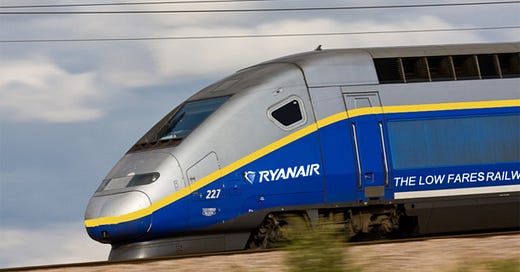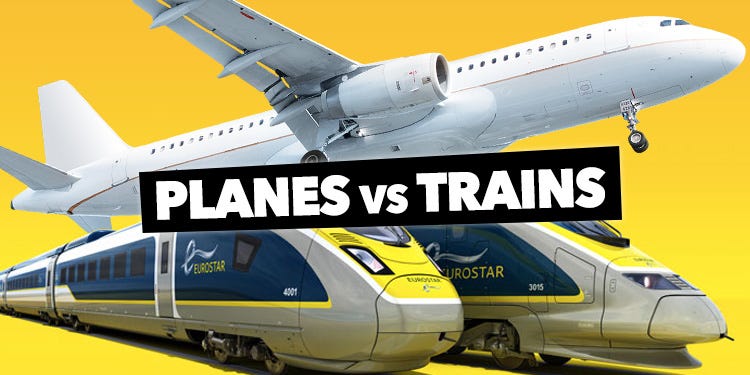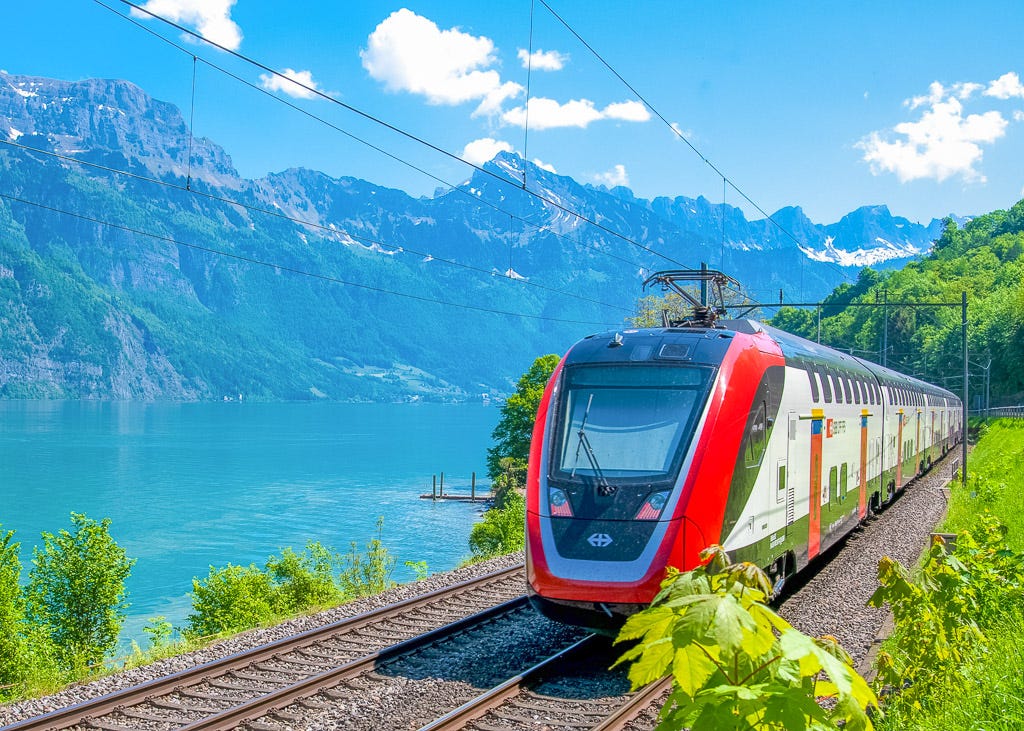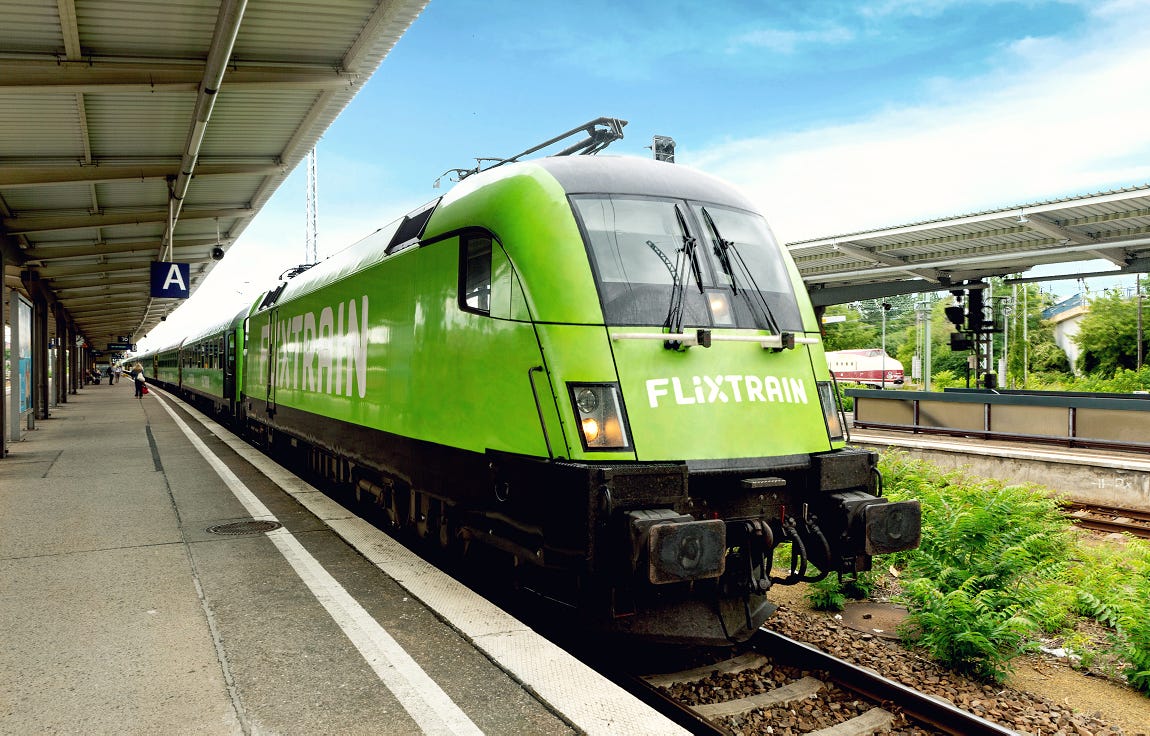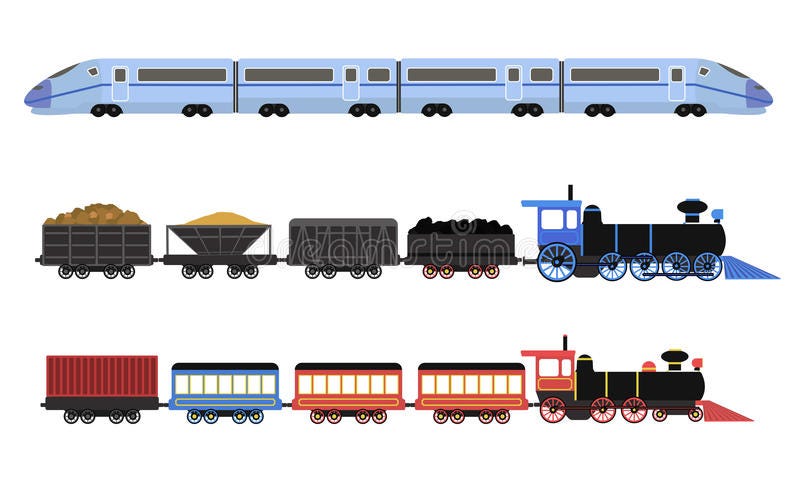Can we Replace Budget-Airlines with Budget-Trains? In Europe, Yes!
The European train network is incredibly big, but horribly inefficient…
When the world thinks of Europe, they think of the trains. No continent’s countries have so collectively chosen to develop such dense and efficient networks of passenger railways.
Technically, you can step on a train above the Arctic Circle in Narvik, Norway, travel exclusively on the rails, and end up all the way at the continent’s border with Asia in Istanbul, but it’s not going to be efficient. That’s because, while possible, this routing touches on the network’s fatal flaw. France, Germany, Spain, Italy, and others have each developed some of the world’s most efficient and effective rail networks, but they’re just not well connected.
Take Milan for example, Europe’s 8th largest metro area. While a world-leading network exists south to the rest of Italy and north into nearby Switzerland, just three trains go farther: A frequent service to Paris, a once-daily trip to Frankfurt, and an overnight train to Munich and Vienna.
This isn’t an isolated edge-case. Paris and Madrid are the European Union’s two largest metro areas, and yet they have zero direct trains running between them. In fact, the farthest one can travel from France’s borders on a direct high-speed train from Paris is London, Amsterdam, Munich, or Milan. And not only is there a dearth of direct trains, but connections are hardly straightforward.
A herculean effort went into digging a tunnel from France to the UK to connect the two countries’ rail networks, and yet in practice, they connected London to the continent—not England, and certainly not the UK. Technical constraints currently prevent practical cross-border passenger service beyond London or by anyone but Eurostar, but the Eurostar service does little to integrate with the UK’s existing domestic network.
To travel from Paris to Manchester, for example, one must individually book the Eurostar from Paris to London, then upon arrival, walk 20 minutes from St Pancras to Euston station to take another train, which also must be booked individually, up to Manchester. The fact that this itinerary cannot be booked as a single ticket both means people are less likely to identify it as a possibility, and that if the first train is delayed enough that the second is missed, there’s no obligation for the operator to rebook the traveler onto the next one. So, while only four hours of train travel stand between France’s largest and the UK’s second largest city—a competitive number versus air travel—these inefficiencies functionally increase it to an untenable level.
Why have airlines become more convenient and cheaper than trains?
The competitor, planes, also significantly undercut trains on fares. Unlike airlines, who price connecting itineraries lower than direct to compensate for the inconvenience, the fact that the two segments of this trip must be booked separately, and are therefore priced separately, makes this functionally impossible, even if it would be a winning strategy. One would be lucky to find a combination of train fares totaling $150 between Paris and Manchester, while airfares on this route typically sit below $100.
This phenomenon is consistent continent-wide. Average train fares between Paris and Barcelona typically sit three times higher than airfares. From Amsterdam to London, it’s four times higher. Cases like Milan to Frankfurt do exist, where trains only cost marginally more, but that’s not the average: in Europe, crossing borders by rail is more expensive and less convenient.
This is no coincidence. The better part of a century ago, as Europe rebuilt and reconnected in the wake of World War Two, countries across the continent searched for opportunities to revitalize their war-torn economies. Several them, especially warm, southern nations like Spain and Italy, identified the potential of tourism.
This conveniently coincided with the opening of the jet age, in which new aircraft development and economies of scale made air travel faster and more affordable. Package holiday providers took advantage of this to offer increasingly inexpensive trips to increasingly far-flung destinations, and some even went further to set up airlines entirely dedicated to flying vacationers like Condor and Britannia Airways. As travel abroad became affordable, cooler coastal towns closer to home, like England’s Margate, Torquay, and Blackpool, started a slow slide into ruin. But simultaneously, to the south, tourist numbers exploded as sunny, seaside towns quickly developed into destinations.
The oil crisis in the 70s stunted this growth, but it soon accelerated again in the 90s as the business model pioneered by Condor, Britannia, and others was refined and innovated upon: the budget airline was born. Ryanair, easyJet, and others not only offered lower fares by themselves, but they also added market pressure that pushed down airfares industry-wide.
Flying was now an approachable luxury, and destinations previously too far for a practical vacation became the most intuitive options. Decades on, budget airlines have thoroughly taken over travel across Europe; they grew out of connecting the north of Europe to its south, but today go east, west, and everywhere in-between.
Meanwhile, the same oil crisis that stunted the growth of international vacationing in the 70s accelerated the development of high-speed rail. Facing a similar resource scarcity decades before, Japan captured the world’s attention by opening the first electric, high-speed rail service between Tokyo and Osaka: The Shinkansen.
Embarrassed by being beaten to the punch, major economies globally started developing their own plans for electric high-speed rail. While the US, UK, Italy, and others made marginal progress in speeding up their trains, the first to properly match the Shinkansen’s speeds was France. On September 22, 1981, France’s Linge à Grande Vitesse Sud-Est opened for passenger service. What was a three hours and forty minutes trip between Paris and Lyon the day before now took just two hours and forty minutes. The engineering effort behind these smooth, gentle tracks was colossal: the construction cost some $18.7 million per mile, or $11.6 million per kilometer. But as the country’s first and third largest cities, a first line between Paris and Lyon made sense, especially since it also reduced travel time to Marseille, the second largest city.
France continued developing the network in this intuitive manner, opening LGV at antique in 1989 to speed up travel to Rennes, Nantes, and Bordeaux, then extending the line past Lyon to speed up trips to Marseille. The nation’s most ambitious connection occurred next with the opening of LGV Nord, which linked Paris to Calais which was the start the start of the brand-new Channel Tunnel to Britain.
Come 1994, just 13 years after the continent's first high-speed train rolled out of the station, it was now possible to take a two-hour trip under the ocean between two of the world’s most economically important cities: Paris and London. This was momentous, but unfortunately, still is momentous…
This is still the most notable example of two European countries collaborating to connect to each other by high-speed rail. It’s an exception to the norm. You see, France’s high-speed network developed from the inside-out. To justify the enormous upfront cost of these rail projects, the politicians behind them focused on connecting the greatest number of French people to the greatest number of other French people: Not Germans, Italians, or Spaniards. Germany did the same, as did Italy, Spain and essentially every nation with high-speed rail in Europe.
This phenomenon is paralleled with the trains themselves. With slower travel speeds and fewer constituents to appease, international destinations have always been an afterthought to the state-owned operators that dominate the European railway industry. Trains primarily serve as domestic transport in Europe; planes dominate the international industry. Perhaps beyond the maps and metrics, the case-studies and figures, the best evidence of the limitations of cross-border European rail travel is the fact that for decades, the EU itself has been working to fix it…
How the EU wants to make train-travel better than airfares
Cutting against the grain of history since the 1990s, the EU has authored reports, drafted directives, and passed regulations seeking to address the two fundamental shortcomings of European rails: A lack of competition, and a lack of cohesion. Identifying the fact that only a measly 6% of travelers went by rail in 2001, the EU bemoaned how a lack of modernization in management and infrastructure had resulted in more road congestion, more bottlenecks, and more car crashes. A series of partially effective laws followed. Citing the fact that intra-EU rail travel remained at 6% in 2013, the EU again recognized that rail had effectively stagnated on account of a lack of competition and standardization and decided something more needed to be done.
In 2016, the EU passed a series of directives and regulations collectively called the Fourth European Rail Package—it was the most comprehensive rail legislation to date. The Fourth Package is broken into two pillars, the Technical and the Market. On the technical side, the process of disbanding nation-run monopolies took a major step forward with the addition of more stringent monitoring and the announcement that public service contracts would become subject to competitive tendering beginning in 2023. The technical side, on the other hand, sought to simplify by expanding the European Union Agency for Railways into a one stop shop for all vehicle registrations, litigation issues, and safety certification.
Together, the bundle of legislation aimed to increase competition and cut away some of the red tape holding back international rail routes. While it was the fourth attempt, the package, along with the three priors, has effectively cracked the market wide open—theoretically, any operator, public or private, can now operate passenger trains anywhere within the European Union. For the first time in a long time, European rail strategy is undergoing fundamental change.
The Ryanair of the train world is coming!
To date, as the EU hoped, the most profound impact of the fourth package and its predecessors is in the increased competition between the old, powerful incumbents: Deutsche Bahn, SNCF, Trenitalia, Rene—and a new wave of scrappy startups and international subsidiaries.
In 2012, a fleet of stylish, brand-new, high-speed trains appeared on recently liberalized Italian rails connecting Naples to Milan. The open access private rail company, Italo, backed by a $1 billion investment, had purchased 25 French Alstom AGV train sets, and started direct competition along the country’s busiest, most densely populated, long distance route.
Offering slightly lower ticket prices; on-board wi-fi; and streamlined, largely automated booking; the private operator took the incumbent Trenitalia head on, and the company took off. Leasing access to the corridor, and outsourcing maintenance and food service to minimize overhead, the service proved viable, and in the years that followed, Italo expanded nationwide, turning its first profit in 2015. Yet rather than siphoning away customers from Trenitalia, Italo’s new service across a critical domestic route unearthed a previously hidden demand.
From 2011 to 2018, while Trenitalia went from commanding all Italian high-speed traffic to only 3/4ths, the revenue pool had grown to such an extent that the company gained business. With competition upping offerings and lowering prices, more Italians were taking the high-speed trains than ever before.
The loser wasn’t Trenitalia, but rather the airlines, as the Rome-to-Milan air passenger numbers halved, and Ryanair gave up the route entirely. Now, the Italo situation was unique in that it took on the incumbent provider directly offering a nearly identical route, with nearly identical service, on nearly identical trains. In a 2016 study of competitive open access rail providers previously and currently operating, of the 34 such companies in Europe, only Italo was high-speed, while 12 offered “low cost, low quality” services and another 11 offered “niche” services like night trains and weekend routings.
In other words, 23 of 34 companies sought to minimize direct competition by offering something different than the incumbent. Flixtrain, for example, entered the German rail scene in 2018 when it took over the Hamburg-Cologne Express line without ever actually buying a single train. Rather than put up major money to challenge Deutsche Bahn’s high-speed trains directly, Flexitarian instead opted to run older, renovated trains leased from Rail pool and operated by the German company IGE to offer an alternative and far cheaper service. So far, it has worked.
The success of Flixtrain’s daily service from Hamburg to Cologne, a route far cheaper and only slightly slower than Deutsche Bahn’s high-speed option, has emboldened the company to expand across Germany, open a line in Sweden, and even offer its first international connection to Switzerland.
Flixtrain might be unique in the fact that it owns no rolling stock, but its budget business model is far from uncommon for the early days of what may well be an open access revolution.
Train-operators are intentionally making fares worse, and that is great news!
What’s happening now in the European railways industry can be compared to the deregulation of the American and European aviation markets from the 1970s. This opened the door for Ryanair, easyJet, Southwest and others to grow into some of the world’s largest and most influential airlines. No longer did airlines have to charge the fares, fly the routes, and offer the service that the government dictated.
Capitalizing on this precedent, SNCF, France’s national rail operator, knew exactly what to do back in 2013 in anticipation of the continent’s coming liberalization. Ouigo was founded with the intention to adapt the low-cost airline business model to the rails. Tickets could only be bought online, rather than at labor-intensive ticket counters. Upcharges were abundant, with luggage and even the use of electric outlets costing extra. Legroom was tighter, staffing was more limited, and daily train utilization was higher.
All around, the experience was worse, but like its airborne equivalent, this was a compromise people were willing to make in exchange for its rock-bottom prices: while its full-service equivalent offers the 90-minute trip between Rennes and Paris for no less than $36, Ouigo sells the same route for as little as $16. While SNCF always had the ability to undercut itself within France, Ouigo was founded with an eye towards the future we’re now living through. It was a test—and seemingly, a successful one—but the ultimate ambitions of Ouigo laid well beyond its home country.
In 2020, when Spain opened up its lines for closely monitored competition, Ouigo España was ready and in 2021, France’s national rail operator started its first route entirely within Spain: Barcelona to Madrid. In quick succession, and in direct response to the success of Ouigo in France, Spain’s national operator, Renfe, founded Avlo to also offer low-cost service between the two cities, and a third competitor, Iryo, is also expected to commence operations on the route later in 2022.
Including the incumbent full-service high-speed train operated by Renfe, that means this route will see four different services competing head-to-head between the same cities: Barcelona to Madrid is becoming the world’s most competitive rail route. A certain extent of this cost-differentiated head-to-head competition seemingly can work, based on the experience of Italo in Italy, and based on the experience of budget airlines. For example, on the London to Barcelona air route, British Airways and Iberia’s passenger numbers stayed relatively consistent throughout the early 2000s, while nearly all the growth can be attributed to easyJet and Ryanair entering the market.
Thanks to budget-operators, more people than ever are switching from planes to trains
The budget operators didn’t only capture demand, they created it. Ouigo has observed something similar. Of passengers surveyed shortly after launch; 50% indicated they would have otherwise taken the full-service alternative; but crucially, 25% said they would have taken the car, bus, or plane; and another 25% said they would not have traveled at all.
Given the parallels in this phenomenon, that means low-cost rail operators don’t need to work within the context of current demand—they don’t need to compete head-to-head on the continent’s busiest routes like Barcelona to Madrid, Paris to Lyon, or Milan to Rome. Because they’re creating rail demand, they can create routes that previously could not have profitably operated given lower passenger numbers. This was how budget airlines took over the world—not through direct competition, but through induced demand. So, continuing the parallels with budget airlines, what we’ll likely see going forward is route innovation, especially focused on appealing to leisure travelers.
We have a long way to go before trains take over planes in Europe…
For train-operators to truly outcompete air-travel, we need a vast network of cross-border trains. Just imagine, for example, a vast network of direct trains from France, Belgium, the Netherlands, and Germany to popular vacation spots to the south like Barcelona, Florence, and Rome. Of course, the barrier to this is travel time. Passengers do tolerate longer travel times in exchange for the convenience and comfort of trains, but only to an extent—there’s still the infrastructure problem.
With track development having always been intertwined with rail service development, which itself has been focused on domestic service, those cross-border gaps in high-speed rail still exist. Getting to Barcelona, Florence, and Rome requires dealing with the inefficiency of the tracks between them and the north. This is where the liberalization of the rails deviates from the liberalization of the skies. Planes only need airports, which exist effectively everywhere. Trains need tracks, which require a level of upfront investment far above what most private companies tolerate. Operators can only induce demand where governments have decided to build tracks.
So, to fulfill their goal of usurping the aviation industry and unlocking the full potential of the next era of rail development, Europe must find a way to view infrastructure from a continental scale, rather than a national one—it must invest in connectivity.
The European train revolution is still in its infancy
To see the current state of European railways, you might get pessimistic. However, I am here to tell you that the European railway is just at the starting line of the upcoming train revolution!
Relative to the aviation industry, Europe’s rail industry is roughly somewhere between 1980 and 2000, as deregulation took full force. What happened next was the fastest 20 years of growth and innovation the industry has ever seen!
This revolution is already starting on the rails. What’s left to decide now, by governments and innovators, is just how precedent-setting the next 20 years of European train travel are going to be.

